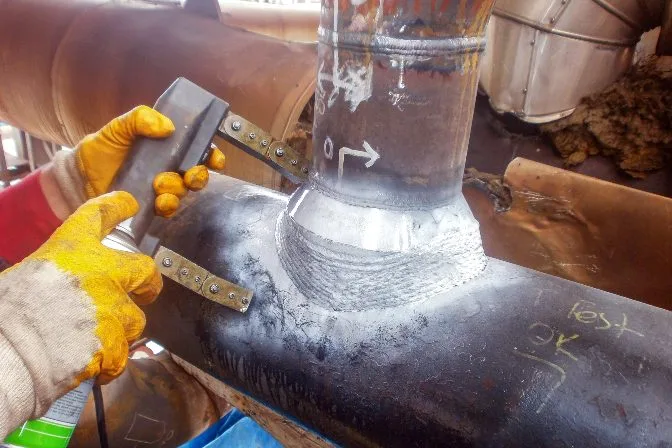The Vital Role of Storage Tank Welding Examination in Ensuring Structural Integrity and Safety And Security Compliance in Industrial Applications
In the world of commercial applications, container welding inspection emerges as a crucial component in protecting architectural stability and making certain conformity with safety and security regulations. Using a mix of strategies such as visual evaluations and progressed testing techniques, these assessments serve to determine and minimize possible imperfections prior to they rise right into substantial risks.
Relevance of Container Welding Assessment

Ensuring conformity with sector standards and policies is another substantial element of tank welding inspection. Regulative bodies mandate strict standards for the building and construction and upkeep of tank, and detailed examinations assist companies comply with these needs. Non-compliance can cause extreme charges, consisting of penalties and shutdowns, even more highlighting the demand for extensive examination protocols.
Furthermore, container welding inspection plays an essential duty in maintaining operational efficiency. In summary, the significance of tank welding examination lies in its ability to protect public health and wellness, secure the atmosphere, and make sure compliance with governing frameworks.
Trick Examination Strategies
Reliable tank welding assessment depends on a selection of crucial strategies that make certain comprehensive examination of weld high quality and architectural stability. Among the most common methods are visual assessment, ultrasonic testing, radiographic testing, and magnetic bit screening - Tank Welding Inspection. Each approach offers distinct benefits in assessing various facets of the weld
Visual examination serves as the very first line of defense, allowing examiners to recognize surface area defects, irregularities, or inconsistencies in the weld grain. Ultrasonic testing utilizes high-frequency acoustic waves to find internal imperfections, such as splits or spaces, offering a thorough evaluation of weld honesty. This method is specifically reliable in identifying issues that might not show up on the surface.
Radiographic testing uses X-rays or gamma rays to generate pictures of the welds, revealing internal suspensions and giving a long-term record for future referral. This method is very efficient for important applications where the danger of failing have to be minimized.
Last but not least, magnetic fragment screening is employed to identify surface and near-surface flaws in ferromagnetic products. By using electromagnetic fields and fine iron fragments, examiners can determine suspensions that might endanger the architectural integrity of the tank. Together, these methods form a robust framework for ensuring high-quality welds in Read More Here industrial applications.
Compliance With Safety And Security Standards

Normal assessments play a pivotal duty in making certain conformity by identifying possible failings or deviations from suggested criteria. Inspectors are trained to assess weld quality, confirm product specifications, and evaluate the overall structural stability of containers. Their knowledge is crucial in making certain that welding processes satisfy the needed safety standards.
Furthermore, conformity with safety requirements not just shields employees but likewise safeguards the setting from potential dangers such as leakages or tragic failures. Organizations that prioritize safety compliance are much better positioned to mitigate risks, improve functional performance, and foster a culture of safety within their labor force. In summary, keeping rigorous conformity with safety standards is essential for the successful operation of tank welding tasks in commercial setups.
Benefits of Normal Inspections
Regular assessments are integral to keeping the architectural integrity and safety of bonded containers. These examinations give an organized technique to determining prospective issues or weaknesses in the welds, making certain that any type of concerns are attended to before they intensify right into substantial failings. By performing routine analyses, organizations can discover deterioration, exhaustion, and various other forms of deterioration that may jeopardize storage tank performance.
Furthermore, consistent assessments add to compliance with sector policies and criteria. Sticking to these standards not just minimizes legal risks yet likewise boosts the organization's online reputation for safety and integrity. Routine assessments promote an aggressive safety culture, encouraging employees to recognize and focus on the value of devices integrity.

Instance Research Studies and Real-World Applications
Study and real-world applications show the tangible impact of efficient container welding assessment practices. One noteworthy instance is a huge petrochemical facility that encountered substantial operational disturbances due to leaks in tank. Adhering to the execution of rigorous welding inspection methods, including aesthetic and ultrasonic screening, the center determined vital flaws in weld seams that can have resulted in catastrophic failures. This positive strategy not only avoided ecological dangers but likewise conserved the business millions in prospective cleaning prices and governing fines.
Likewise, a water therapy plant applied an extensive examination program click to read more for its storage tank welding operations - Tank Welding Inspection. By including non-destructive screening approaches, the plant had the ability to discover very early indications of corrosion and tiredness in weld joints. This timely intervention expanded the life expectancy of the storage tanks and ensured compliance with security policies, therefore protecting public wellness
These study underscore he has a good point the significance of routine and systematic tank welding inspections. By prioritizing these techniques, industries can mitigate dangers, boost structural honesty, and ensure conformity with safety and security requirements, eventually causing boosted functional efficiency and minimized liabilities.

Verdict
In verdict, container welding inspection is a crucial part of maintaining architectural honesty and safety and security in industrial applications. Using numerous inspection methods guarantees very early discovery of prospective defects, therefore avoiding devastating failures.